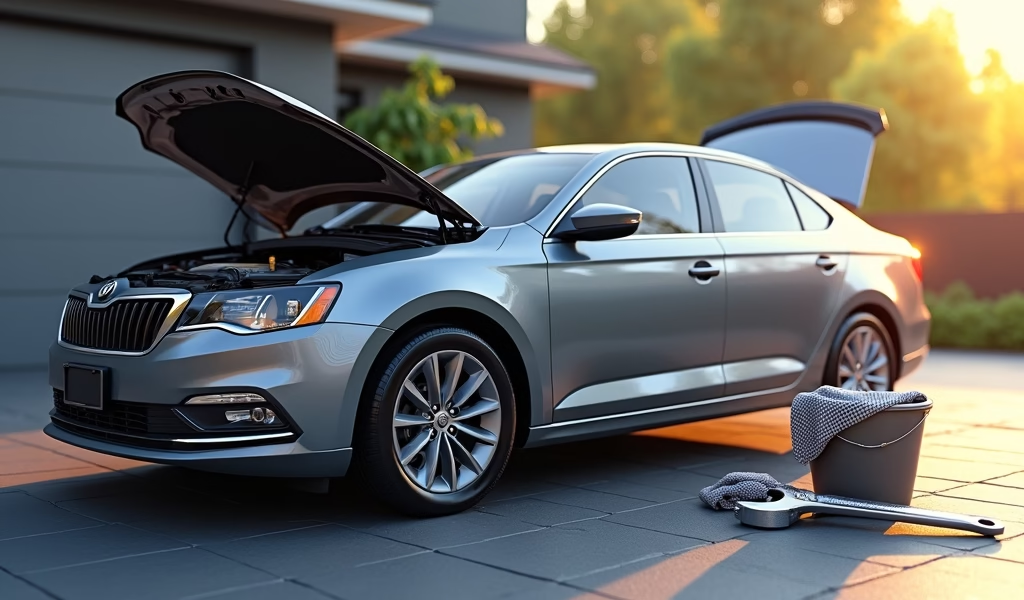Overview
This mechanic’s guide to buying used cars covers essential steps from pre-purchase research and vehicle history checks to professional inspections and post-purchase maintenance. It emphasizes the importance of thorough evaluation before buying, including visual inspections and test drives, while offering negotiation strategies and financing advice to help buyers make informed decisions and avoid costly mistakes.
Table of Contents
- Smart Used Car Buying: A Mechanic’s Perspective
- Research Before Shopping: Your First Defense
- Vehicle History Check: Uncovering the Past
- Visual Inspection: What Your Eyes Can Tell You
- Test Drive Essentials: Beyond a Quick Spin
- Professional Inspection: Your Best Investment
- Negotiation Strategies: Getting a Fair Deal
- Financing Considerations: Smart Money Moves
- After-Purchase Care: Protecting Your Investment
- Conclusion: Driving Away Confidently
- Frequently Asked Questions
Smart Used Car Buying: A Mechanic’s Perspective
Looking for tips for buying a used car? You’re making a smart move by doing your homework first. After 20 years under the hood, I’ve seen plenty of folks who skipped their due diligence and ended up with expensive regrets. A used car can be a fantastic value—if you know what you’re doing.
The used car market is packed with options, from nearly-new certified pre-owned vehicles to high-mileage bargains. But here’s the truth: every used car has a story, and not all of them have happy endings. Learning how to read those stories can save you thousands in unexpected repairs and headaches.
Think of this guide as your personal walkthrough from someone who’s examined thousands of vehicles. I’ll share the exact process I use when helping friends and family evaluate their potential purchases. Let’s turn you into a more confident buyer who can spot both hidden gems and money pits before signing any paperwork.
Research Before Shopping: Your First Defense
Smart car buying starts long before you set foot on a lot or meet a seller. Begin by narrowing down your options based on your actual needs—not just what looks good. Do you need cargo space for family trips? Fuel efficiency for long commutes? Four-wheel drive for winter conditions? Write down your non-negotiables.
Once you’ve identified a few models that fit your requirements, it’s time to dig deeper. Check reliability ratings from sources like Consumer Reports and review common problems for specific model years. Every vehicle has its quirks, but some have serious design flaws that can drain your wallet.
Research typical maintenance costs too. German luxury brands might offer tempting purchase prices when used, but their parts and service costs can be substantially higher than Japanese or American counterparts. As a mechanic, I’ve seen too many folks buy more car than they could afford to maintain.
Before starting your search, determine your budget and stick to it. Remember to account for insurance, taxes, registration, and an emergency repair fund. A good rule of thumb: set aside at least $1,000 for unexpected issues that might crop up in the first few months of ownership. Your future self will thank you for this foresight.
Finally, research current market values using resources like Kelley Blue Book or Edmunds. Understanding fair pricing gives you leverage and helps you recognize both good deals and overpriced listings. Armed with this knowledge, you’re ready to start looking at actual vehicles with a critical eye.

Vehicle History Check: Uncovering the Past
Never—and I mean never—buy a used car without checking its history report first. Services like CarFax and AutoCheck can reveal accidents, flood damage, title problems, and service records that the seller might conveniently forget to mention. The small cost of these reports is insignificant compared to the financial protection they provide.
The Vehicle Identification Number (VIN) is your key to unlocking this information. You’ll find this 17-character code on the dashboard near the windshield, driver’s side door jamb, and often on the vehicle’s title or registration documents. Be suspicious if a seller is reluctant to provide this information—they may be hiding something significant.
Here’s what to look for in a vehicle history report:
- Accident history and severity (minor fender benders are less concerning than frame damage)
- Title status (avoid salvage, rebuilt, or flood titles unless you’re a specialist)
- Number of previous owners (fewer is generally better)
- Service records (regular maintenance is a strong positive indicator)
- Odometer readings over time (to check for potential rollbacks)
- Recall information (and whether those recalls were addressed)
Pay special attention to any gaps in the service history. While not all owners record every oil change, long periods without any documented maintenance could signal neglect. Similarly, if the car has bounced between many owners in a short period, there might be an underlying issue that keeps prompting people to sell.
Remember that history reports aren’t infallible. Some incidents, particularly minor repairs or accidents settled privately, might not appear. That’s why the report is just one tool in your evaluation arsenal, not the final word on a vehicle’s condition.
Visual Inspection: What Your Eyes Can Tell You
Before you get caught up in features and test drives, take time for a methodical visual inspection. I recommend examining used cars in daylight on dry days—rain can hide paint issues, and darkness conceals many flaws. Bring a flashlight anyway to peer into dark corners and underneath the vehicle.
Start with a slow walk around the exterior. Look for paint inconsistencies, panel gaps, or mismatched colors that might indicate previous damage repair. Check that all doors, the hood, and trunk open and close smoothly. Uneven panel gaps often tell the tale of collision repair that may not have been properly documented.
Examine all glass surfaces for cracks or chips, especially the windshield. Small chips can quickly spread into cracks requiring full replacement. While you’re at it, test all lights—headlights, brake lights, turn signals, and interior lighting. Electrical issues can be particularly troublesome and expensive to diagnose.
Tire inspection reveals more than you might think. Uneven wear patterns can indicate alignment problems or worn suspension components. All four tires should match in brand and model—mismatched tires may suggest hasty repairs after an accident. Don’t forget to check the spare tire and tools while you’re at it.
Inside the cabin, give everything a thorough once-over. Test all controls, buttons, and features. Verify that the air conditioning blows cold, the heater produces heat, and that all power accessories function properly. Worn pedals, steering wheels, or seat bolsters that don’t match the claimed mileage might suggest odometer tampering.
The first-time car buyer might feel overwhelmed by this process, but taking your time here saves headaches later. Create a simple checklist on your phone to ensure you don’t miss anything important during your inspection.
Test Drive Essentials: Beyond a Quick Spin
A proper test drive isn’t a quick trip around the block—it’s your opportunity to experience how the vehicle performs in various conditions. Plan for at least 30 minutes behind the wheel, ideally on different road types. Include highway driving to check for stability at speed and neighborhood streets to test low-speed handling.
Start the engine from cold if possible. Listen carefully during startup—unusual noises or excessive smoke from the exhaust can indicate serious engine problems. Watch the dashboard for warning lights that might briefly illuminate during the system check but shouldn’t remain on.
While driving, pay attention to these critical aspects:
- Acceleration: The car should respond smoothly without hesitation or jerking
- Braking: Stops should be straight and steady without pulling to either side
- Steering: Check for excessive play, unusual resistance, or alignment issues
- Transmission: Shifts should be smooth, not rough or delayed
- Suspension: Drive over bumps to test for unusual bouncing or bottoming out
- Unusual noises: Listen for clunks, rattles, or whines that could indicate problems
Test all driving modes and features during your drive. If the vehicle has four-wheel drive, make sure to engage it. Try the cruise control, check blind-spot monitors if equipped, and test the parking sensors or cameras. These electronic systems can be expensive to repair if faulty.
Don’t be shy about adjusting the seat, mirrors, and controls to your comfort. You need to determine if this vehicle fits your body and driving style. A car that’s uncomfortable during a test drive won’t become more comfortable after purchase.
Finally, find a safe place to perform a few specific handling tests: quick stops, sharp turns (at appropriate speeds), and if possible, parallel parking. These maneuvers can reveal issues that might not be apparent during regular driving.

Professional Inspection: Your Best Investment
Even with thorough research and a careful personal inspection, nothing replaces a professional mechanic’s evaluation. For around $100-200, you’ll get an expert assessment that could save you thousands in unexpected repairs. As a mechanic myself, I can’t count how many times I’ve identified serious issues that were invisible to untrained eyes.
If a seller refuses to let you take the car for an independent inspection, walk away immediately. This reluctance is a major red flag and suggests they’re hiding something significant. Reputable dealers and honest private sellers understand this is a standard part of the used car buying process.
A proper pre-purchase inspection should include:
- Comprehensive engine and transmission evaluation
- Electrical system testing
- Undercarriage examination for damage, leaks, or corrosion
- Suspension and steering component assessment
- Brake system inspection (including pad measurements)
- Fluid analysis (color, level, and condition)
- Diagnostic computer scan for error codes
Ask the mechanic to provide a written report with their findings and estimated repair costs for any issues discovered. This documentation serves two purposes: it helps you make an informed decision and potentially gives you negotiation leverage if problems are found.
Don’t let emotional attachment to a particular vehicle cloud your judgment. If the inspection reveals significant problems, be prepared to walk away regardless of how much you like the car. Remember, the used car market is vast—there’s always another option waiting that won’t come with major headaches.
Some sellers may offer to have their mechanic perform the inspection. While this can provide some information, always insist on using your chosen independent professional. The American Automobile Association recommends finding a trusted, certified mechanic who has no financial interest in the transaction.
Negotiation Strategies: Getting a Fair Deal
Armed with research and inspection results, you’re now in position to negotiate effectively. Remember that used car prices typically have more flexibility than new cars, especially with private sellers. However, that doesn’t mean aggressive tactics are necessary—professional, informed negotiation usually yields better results than confrontation.
Start by establishing the vehicle’s fair market value based on condition, mileage, and features. If your inspection revealed issues requiring repair, factor those costs into your offer. Present this information matter-of-factly, not as accusations or complaints. Most sellers appreciate an educated buyer who knows what they’re talking about.
When making an offer, be clear and specific. Instead of saying “Can you do better on the price?” try “Based on the market research and considering the transmission service it needs, I’m prepared to offer $X.” This approach shows you’ve done your homework and have a reasonable basis for your offer.
Be prepared to walk away if the numbers don’t work for your budget. Emotional attachment to a particular vehicle can cloud judgment and lead to poor financial decisions. Remember that the process of buying a used car often involves looking at multiple options before finding the right match.
If you’re financing, understand that the purchase price is only one component of the transaction. Interest rates, loan terms, and fees can dramatically affect your total cost. Get pre-approved for financing before shopping to strengthen your negotiating position and avoid dealer financing surprises.
Financing Considerations: Smart Money Moves
Unless you’re paying cash, financing will significantly impact the total cost of your used car purchase. Credit unions often offer the most competitive rates, followed by banks, with dealership financing frequently being the most expensive option. Shop around for pre-approval before setting foot on a lot.
Understand the relationship between loan term and total cost. Longer loans mean lower monthly payments but substantially higher interest payments over time. As a general rule, try to keep your car loan term to 60 months or less, even if it means purchasing a less expensive vehicle.
When comparing loan offers, focus on the Annual Percentage Rate (APR) rather than monthly payment. Dealers sometimes emphasize the monthly payment while extending the term or adding fees that increase your total cost. Always ask for a breakdown of all fees and the total amount you’ll pay over the life of the loan.
Consider making a larger down payment if possible. This reduces your loan-to-value ratio, which can help secure better interest rates and provides an equity cushion against depreciation. Aim for at least 20% down if your budget allows.
Gap insurance might be worth considering, especially if you’re making a minimal down payment on a vehicle that depreciates quickly. This coverage protects you if the car is totaled and you owe more than its current value. However, if you’ve made a substantial down payment, you may not need this additional insurance.
After-Purchase Care: Protecting Your Investment
Congratulations on your purchase! Now let’s make sure your used car serves you well for years to come. First, create a maintenance schedule based on the manufacturer’s recommendations in the owner’s manual. Regular maintenance prevents small issues from becoming expensive problems.
Even if the previous owner kept maintenance records, establish your own baseline. Consider changing all fluids after purchase—oil, transmission fluid, coolant, brake fluid, and power steering fluid. This fresh start helps you know exactly when each service was last performed.
Create an emergency fund specifically for car repairs. Even well-maintained used cars will eventually need work. Setting aside even $50-100 per month can prevent a necessary repair from becoming a financial crisis. Remember, ignoring small issues often leads to more expensive problems down the road.
Pay attention to how your car drives, sounds, and feels. Many major issues give early warning signs that, if addressed promptly, can be fixed before causing extensive damage. Unusual noises, vibrations, smells, or dashboard warning lights deserve immediate attention.
Consider investing in an extended warranty only after careful research. Quality and coverage vary dramatically between providers. Some offer comprehensive protection while others have so many exclusions they provide little real value. Read the fine print and check the warranty company’s reputation before purchasing.
Conclusion: Driving Away Confidently
Following these tips for buying a used car transforms what could be a stressful experience into a confident, informed decision. By conducting thorough research, carefully inspecting potential purchases, and getting professional evaluations, you dramatically reduce your risk of ending up with a problematic vehicle.
Remember that patience is your ally in the used car market. The perfect combination of vehicle, condition, and price is out there if you’re willing to take your time. Rushing the process often leads to compromises you’ll later regret.
The most successful used car purchases happen when buyers approach the process methodically, using both their head and their mechanical knowledge (or that of a trusted professional). By following the advice in this guide, you’re well-equipped to find a reliable vehicle that fits both your needs and budget.
Ready to start your used car search? Put these tips into action today. Make your checklist, research your target models, and begin the process with confidence. Your future self will thank you for the time and care you invest now. Happy hunting and safer driving!
Frequently Asked Questions
What’s the best mileage range when buying a used car?
Look for vehicles with 30,000-80,000 miles for the best balance of value and remaining life. Modern vehicles can easily exceed 200,000 miles with proper maintenance, so condition matters more than an arbitrary mileage number.
Is a Certified Pre-Owned vehicle worth the extra cost?
CPO vehicles often provide better warranties and have undergone more rigorous inspections, making them worth considering for peace of mind. However, you’ll still want to conduct your own research and inspection to ensure you’re getting value for the premium price.
Should I avoid cars that have been in accidents?
Minor accidents don’t necessarily disqualify a vehicle if repairs were properly done by reputable shops. However, vehicles with structural or frame damage, airbag deployment, or flood damage involve significantly higher risk and should generally be avoided.
How can I tell if a car’s odometer has been tampered with?
Look for inconsistencies between the vehicle’s wear patterns and its claimed mileage. Check service records and vehicle history reports for mileage discrepancies, and examine dash components for signs of removal or replacement.
Is it better to buy from a dealer or private seller?
Dealers typically offer some legal protections and possibly warranties, while private sellers usually offer lower prices. Your best choice depends on your risk tolerance, budget constraints, and mechanical knowledge level.

